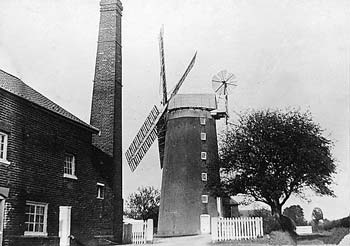
|
Besthorpe
towermill |
 |
|
c.1930
|
Besthorpe towermill stood in Mill Lane and in later years was worked in conjunction with a steam mill that stood beside it. The mill tower was 6 storeys high and used 4 double shuttered sails, each with 8 bays of 3 shutters, struck by a rocking lever to power 3 pairs of French burr stones and a flour dresser. The towermill had patent sails and a boat shaped cap with a petticoat and an 6 bladed fantail. |
The brake wheel was made of elm and oak reinforced with a flat oak frame to the front. The stone nuts and thus the stones were overdriven and taken out of mesh by screwing out a bearing block of quant. The horses were made of cast iron. |
The towermill was was possibly built with clay lump. The only other towermills known to have been built of clay lump were Attleborough Station towermill and Carleton Rode towermill although the earlier postmill that stood beside the towermill had a clay lump roundhouse. |
The three pairs of stones in the steam mill were driven by a 12hp high pressure expansive condensing engine. |
TITHE AWARD 1847 |
||||
| No. 59 | House, Mill, Premises & Yard | Pasture | 0a. 3r. 14p. | 4s. 8d. |
Situations Vacant |
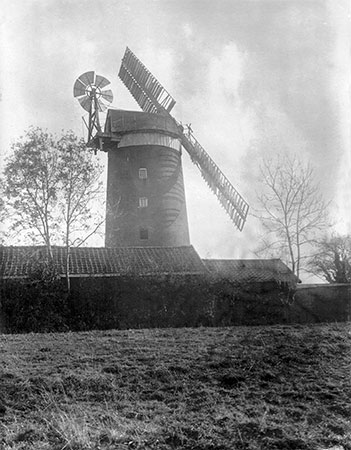 |
|
c.1931 |
To Parents & Guardians |
Situations Vacant |
Miscellaneous |
Situations Vacant |
Situations Vacant |
 |
 |
c.1933 |
18th May 1935 |
To Millers & others FOR SALE with possession at Michaelmas or Christmas BESTHORPE MILLS Within a Mile of Attleborough Station & close to the Turnpike Road All that desirable FREEHOLD PROPERTY situate at Besthorpe in a good Corn growing District comprising a fine Tower Windmill with six Floors, Patent Sails, driving three pairs of French Burr Stones; also a detached Steam Mill with a 12 h.p. high pressure expansive condensing Engine driving three pairs of French stones, together with all requisite Machinery, capital Storage & Miller’s Cottage. Also a newly erected Red Brick & Slated Dwelling House, 3-stall Stable, Gig house, Lawn & Garden, Paddock & small pightle of Arable Land containing in all 2a.3r.7p. The whole is Freehold & Land Tax redeemed. An excellent Trade has been successfully carried on for about half a century by the present Proprietor & his Father & the Property is well worth attention either for occupation or investment. Particulars of Messrs. Salter & Simpson, Offices Attleborough, or of Mr. R. J. Lovett on the premises. Norfolk Chronicle & Norfolk News - 25th May & 1 June 1872 |
Besthorpe near Attleborough |
Situations Vacant |
Situations Vacant |
Situations Vacant |
Notice re |
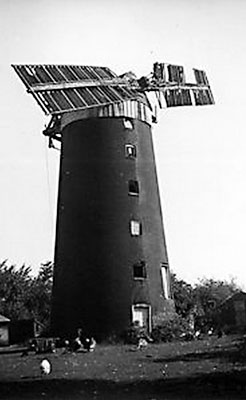 |
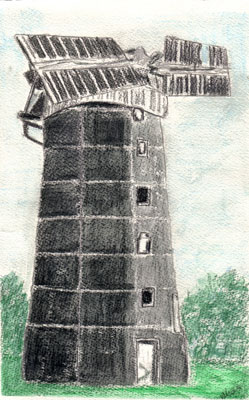 |
12th September 1934 |
Copy of 1934 photo by
Muriel Paquette |
Besthorpe |
Besthorpe & Attleborough |
Besthorpe Mills near Attleborough |
Preliminary Notice |
Besthorpe, Norfolk. |
Property Market |
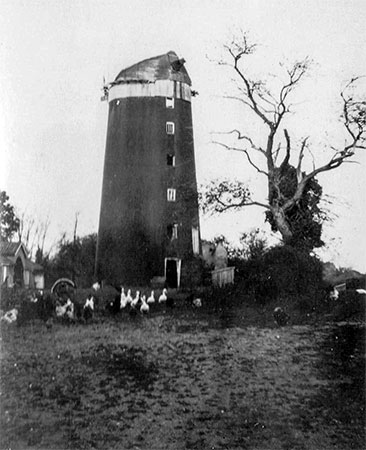 |
7th November 1938 |
I went to see Mrs Leman at Mill House, Mill Lane, Besthorpe. She is the widow of the miller there. She told me that there were 2 mills. The post mill to the east definitely had a clay lump shed round it. She was not sure that the Tower mill was lump. The mill was said to be a landmark during the last war and was blown up by the Americans. Her husband did not object because there was a crack in it. She saw it blown up. It took several goes (confirmed by Clifford Eagling, School Cottage, Besthorpe). She said that the white American officers stood with the crowd on the road while the black servicemen placed the explosives and objected to the danger. "Black Americans did the dirty work". She has photographs. Six stories high. The windows were all above one another. She told me to see Claud H. Thompson, Church House, Silver Street, Besthorpe, who is 90, who had owned the mill before her husband. He confirmed that the mill was of clay lump. The mills in Attleborough were at Tyrrell and Byfords Yard near the Station and on the South side of Hargham Road. Mr Thompson said that he had helped make clay lumps and had ridden the horse round the treading bed. The last clay lumps he knew were made next door to Church House and were carried to Morley to build two houses by Mr Lusher (his younger brother Fred Lusher still lives in White Horse Lane). Prompted by my questions he described the process as follows:- The clay was brought into the yard from the adjacent or nearby field in horse and tumbrels. The clay was laid out on the grass about 9" or more deep. It was covered with barley straw or chaff (he called it something else, which was the stuff that came out of the thresher and had long bits in it). Tough and thick wheat straw were not used. Dried spear grass was the best. The clay was watered and trodden. The clay was put into a mould with a shovel and patted down with the shovel. One man did the moulding immediately next to the treading. Treading was done in "smaller lots". He could not remember how many were made in a day. The blocks were laid about 6" apart so that they could be turned which they were frequently. How long they were on the ground depended on the weather. They were stacked with spaces between, sometimes for over a year. The Workhouse at Besthorpe is of Clay Lump. Dirk Bouwen - 12th January 1988 |
The towermill was blown up by the Americans c.1943 as they considered it to be a land mark for the Luftwaffe and the resulting rubble was used to help build New Buckenham airfield. |
Mrs. Leman still lives at Mill House, but Mr. Leman died earlier this year. A new house (The Mill, No. 38 Mill Lane) has been built by Mr. Leman’s son-in-law, David Gardiner, between Mill House and the site of the tower mill, steam/oil mill and the outbuildings. In 1981 Mr. Gardiner and his father discovered the foundations of the tower mill left when it was demolished. These have been repaired to the level of the surrounding lawn and form a brick circle the outside diameter of which is 23 ft. 8 ins. The tower wall at ground level is 2 feet thick giving a floor diameter of 19 ft. 8 ins. Harry Apling - 2nd July 1985 |
I have been looking for information on Besthorpe for my father. My father (now 80 and recently a widower) was evacuated with the Leman family at Besthorpe Mill during the war and has the most wonderful memories of the family and the area. We are going to arrange for a visit sometime in the spring and wondered if there is anyone we could contact who might be living at the house now. |
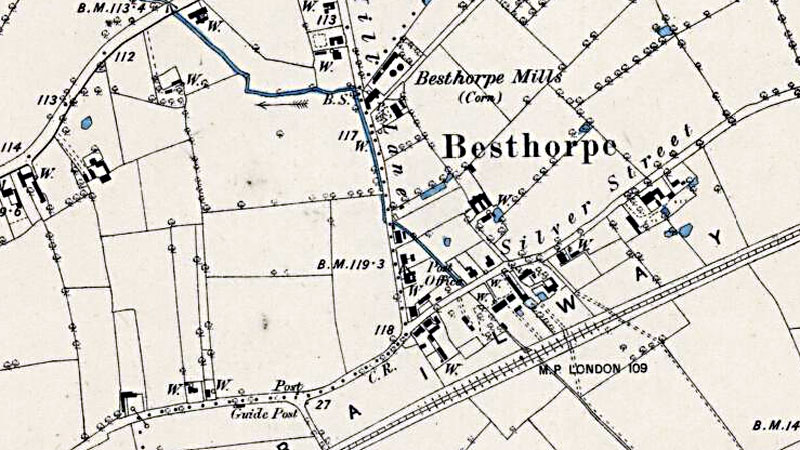 |
Towermill and steam mill - O.S. Map 1881-82 Courtesy of NLS map images |
| Pigot's 1830: Robert Lovett, miller, Bisthorpe Greenwood's map 1834: 2 mills White's 1836: Robert Lovett, corn miller Whites 1845: Robert Lovett, miller Tithe Award 1847: Owner & occupier: Robert Lovett 1853: Robert Lovett, miller Whites 1854: Robert James Lovett, corn miller 1857: Robert James Lovett, miller
Whites 1864: Robert James Lovett, corn miller 1872: Robert James Lovett, miller May 1872: Mill advertised for sale September 1872: Household furniture and ancilliary mill equipment of R.J. Lovett advertised for sale by auction October 1872: George Greenacre, miller 1875: George Greenacre, miller 1878: George Greenacre died Kelly's 1879: George Greenacre, miller, merchant & farmer, Besthorpe mills
White's 1883: George Greenacre, miller & farmer O.S. map 1884: Besthorpe Mills (Corn)
Kelly's 1896: George Greenacre, miller (steam & wind) & merchant & farmer, Besthorpe mills
July 1900: Mills advertised for sale by auction |
If you have any memories, anecdotes or photos please let us know and we may be able to use them to update the site. By all means telephone 07836 675369 or
|
| Nat Grid Ref TM 05989602 |
Copyright © Jonathan Neville 2004 |